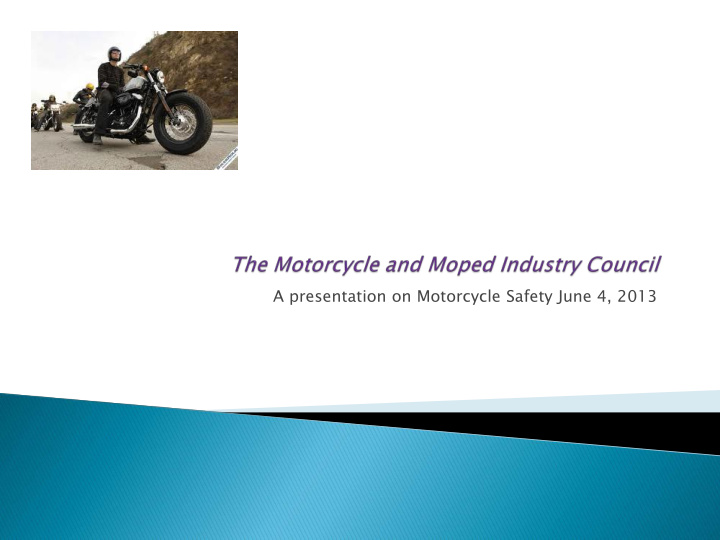



A presentation on Motorcycle Safety June 4, 2013
MMIC is a national, non-profit trade association MMIC has been in existence since 1971 We represent manufacturers and distributors motorcycles, scooters and ATVs We are totally self-funded MMIC Motorcycle Brands: Aprilia, BMW, BRP (Spyder), Ducati, Harley- Davidson, Honda, Kawasaki, KTM, Moto Guzzi, Piaggio, Suzuki, Triumph, Vespa, Victory and Yamaha.
MMIC members represent 95% of motorcycles and scooters sold in Canada In 2010, the combined industry was worth $1.5B Approximately half of that, $618M, were new motorcycle sales Approximately 40 dealerships in Saskatchewan
As an organization, we put a priority on safety – our customers are our family MMIC has been involved in motorcycle rider safety since the mid - 70’s MMIC has actively supported mandatory helmet legislation for motorcycle riders and passengers with no exceptions. MMIC has supported graduated licensing since 1990’s and is favourable to some learner stage restrictions. MMIC supported these measures because studies indicated they were correlated with greater risk!
Willing to work with province on mc rider safety for lasting impact Support enhanced mc rider training, safety education, and science-based GDL Strategies linked to accident causes in 16-25 age group Call on the province for a research on causation factors
What are the causation factors? Why we have these accidents? Speed, impaired, actions of other road users? How to identify solutions without proper causes?
Number of vehicles in collisions by vehicle type total ◦ Motorcycles 2006 394 2011 290 Motorcycle collisions by year total ◦ Persons injured 2006 204 2011 214
Stable rate Positive because of increase of 3000 registrations Saskatchewan past 5 years, over 12 000 new motorcycles sold 25 000 registered motorcycles
Ri Rider er traini ining g incenti entives es reduction in premium reduction of learner stage Be Better ter Educatio cation: Teach riders how to brake properly and better risk analysis Teach riders how to react better in an accident situation – prevent panic and freezing up The testing protocol should be reviewed to raise the standards for the actual road conditions faced There should be more emphasis on realistic training of motorcycle riding Smar arter ter Re Regula ulatio tions: ns: New safety regulations should use road restrictions for novice motorcyclists including 0 BAC, no carrying passengers or no night riding Review driver safety records strategic focus should be on educating and training better motorcyclists
critical itical safety ety aspects ects: 1 out of 3 motorcyclists do nothing to react in an accident situation 3 out of 4 don’t use front brakes – they use rear brakes which do not exert as much stopping force The New Zealand Motorcycle Safety Consultants refer to this as a “Brain Dump”. The human brain can’t process the sudden incidents, and forgets everything except the most hardwired instinct False perception of taking a curve too fast causes bikes to swerve out across centerlines Motorcycle riders in accidents show significant collision avoidance problems. Most riders would overbrake and skid the rear wheel, and underbrake the front wheel greatly reducing collision avoidance deceleration. The ability to countersteer and swerve was essentially absent (Hurt Report 417)
For years governments have considered power restrictions to improve motorcycle safety but most jurisdictions have rejected this approach Why? because there is no independent statistically significant research that supports such an approach. Major studies (MAID, Hurt Report and TIRF Study) indicate there was no causal relationship between engine capacity and accidents
More research into behavioral issues is required. This is particularly true for the 16-25 age group in order to establish strategies that are directly linked to accident causes, i.e. speeding or impaired riding. MMIC believes you need behaviorial change to see a decrease in the rate of deaths and accidents in that age group. Only when you have clear and specific data will you be able to reach that specific public directly and effectively.
We believe that unless there is behavioural change – significant progress cannot be made in the key target group of 16-25 year olds MMIC supports safety measures that work, based on studies and evidence MMIC is willing to work with the province to develop other motorcycle safety standards that will have a real and lasting impact
Recommend
More recommend